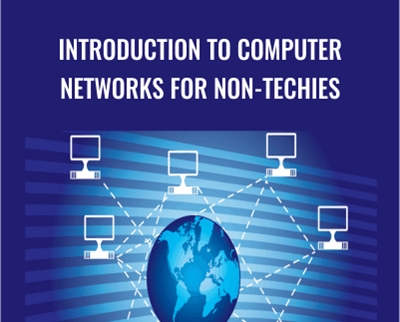Introduction to Computer Networks for Non-Techies – Alton Hardin
Original price was: $49.00.$15.00Current price is: $15.00.
Introduction to Computer Networks for Non-Techies – Alton Hardin Download. This course will teach you the fundamentals of computer networking and how compu…
Salepage link: At HERE. Archive: https://archive.is/sR6Hj
Hours of Content: 6
COMPUTER NETWORKING DEMYSTIFIED FOR NON-TECHIES
Are you a non-techie interested in learning about computer networks? Are you a business or aspiring IT professional that needs to better understand how networks work? Then you have come to the right place!
This course will teach you the fundamentals of computer networking and how computer networks work, designed for Non-Techies!
WHAT YOU’LL LEARN IN THIS COURSE:
- The Benefits of Computer Networks
- How Computer Networks Work
- Network Topologies
- Networking Devices & Cabling
- The OSI & TCP/IP Models
- IP Addressing & Subnetting
- Network Planning & Designing Process
Once you complete this course, you’ll understand how computer networks work and how to plan and design a computer network!
What are the requirements?
- A Basic Understanding of Computers
- A Desire to Learn
What am I going to get from this course?
- Understand How Computer Networks Work
- Know the Inner Workings of a Computer Network
- Understand the Benefits of Computer Networks
- Know How to Effectively Plan and Design a Computer Network
What is the target audience?
- Non-Techies Wanting to Learn About Computer Networks
- Business & IT Managers Needing a Working Knowledge of Computer Networking
- Aspiring & Inexperienced IT Professionals
- This Course Is NOT for Seasoned & Experienced IT & Neworking Professionals
Course Curriculum
Course Introduction
- 1. Course Introduction and Overview (3:21)
- 2. What This Course Is & What It Isn’t
- 3. Instructor Introduction (1:21)
Overview and Benefits of Computer Networks
- 5. What Is a Computer Network (5:00)
- 6. Some Basic Computer Networking Rules (3:28)
- 7. Why Build a Computer Network (3:57)
- 8. How Computer Networks Impact Our Daily Lives (5:26)
- 9. Benefits of Computer Networks (3:39)
How Computer Networks Work
- 10. Section Introduction
- 11. Introduction to Computer Networking Protocols (4:22)
- 12. Introduction to the OSI Model (10:41)
- 13. Introduction to the TCP/IP Model (4:47)
- 14. Introduction to MAC Addresses (9:03)
- 15. Introduction to IP Addresses (6:47)
- 16. IP versus MAC Addresses (3:37)
Network Topologies
- 17. LANs and WANs (8:20)
- 18. Peer-to-Peer Network Architecture (10:11)
- 19. Client-Server Network Architecture (6:23)
- 20. Common Networking Components (7:59)
- 21. Introduction to Physical Network Topologies (3:01)
- 22. Common Physical Network Topologies (14:30)
- 23. Physical Network Topology Selection Criteria (6:02)
- 24. Network Design Scenarios Introduction (0:48)
- 25. Class Follow-Along Exercise- Network Design Scenario #1 (6:51)
- 26. Class Follow-Along Exercise- Network Design Scenario #2 (2:28)
- 27. Class Follow-Along Exercise- Network Design Scenario #3 (5:11)
Networking Devices
- 28. Section Introduction
- 29. Network Interface Cards (2:09)
- 30. Hubs (3:24)
- 31. Switches (5:08)
- 32. Hubs versus Switches (2:29)
- 33. How a Switch Learns MAC Addresses (5:53)
- 34. Wireless Access Points (2:16)
- 35. Routers (3:27)
- 36. Introduction to the Packet Routing Process (5:49)
- 37. Firewalls (2:36)
- 38. DHCP Servers (2:28)
- 39. All-in-One SOHO Devices (2:19)
Network Cabling
- 40. Section Introduction
- 41. Importance of Network Cabling (1:36)
- 42. Types of Network Cabling (2:07)
- 43. Twisted Pair Copper Network Cabling (7:16)
- 44. Fiber Optic Network Cabling (7:55)
- 45. Twisted Pair Copper Wiring Standards (5:33)
- 46. Networking Cable Selection Criteria (3:40)
- 47. Straight Through versus Cross Over Network Cables (6:19)
The OSI Model
- 48. OSI Model Overview (4:24)
- 49. OSI Layer 7 – The Application Layer (2:51)
- 50. OSI Layer 6 – The Presentation Layer (2:10)
- 51. OSI Layer 5 – The Session Layer (1:29)
- 52. OSI Layer 4 – The Transport Layer (2:48)
- 53. OSI Layer 3 – The Network Layer (2:37)
- 54. OSI Layer 2 – The Data Link Layer (2:14)
- 55. OSI Layer 1 – The Physical Layer (1:13)
- 56. OSI Model Data Encapsulation and Decapsulation (5:12)
Planning a Network
- 57. Why We Plan (5:10)
- 58. The Overall Process (3:05)
- 59. Understanding the Business (3:11)
- 60. Establishing a Business Need (4:04)
- 61. Defining Specific Areas of Improvement (3:07)
- 62. Buy-in and Resources (1:35)
- 63. Hidden Costs (4:17)
- 64. Other Considerations (3:38)
- 65. Planning Questions (2:53)
- 66. The Next Steps (2:08)
Introduction to TCP/IP
- 68. What is TCP/IP (1:06)
- 69. TCP/IP Protocols (0:45)
TCP/IP Network Layer Protocols
- 70. Address Resolution Protocol (ARP) (4:32)
- 71. Internet Protocol Version 4 (IPv4) (3:47)
- 72. Internet Protocol Version 6 (IPv6) (2:10)
- 73. Internet Control Message Protocol (ICMP) (5:31)
TCP/IP Transport Layer Protocols
- 74. TCP/IP Transport Layer Protocols (0:41)
- 75. Transmission Control Protocol (TCP) (3:33)
- 76. User Datagram Protocol (UDP) (3:37)
- 77. TCP versus UDP (2:43)
Common TCP/IP Application Layer Protocols
- 78. Common TCP/IP Application Layer Protocols (0:58)
- 79. Management Protocols (4:16)
- 80. Remote Communication Protocols (2:43)
- 81. File Transfer Application Protocols (5:10)
- 82. Mail Application Protocols (4:10)
- 83. Browser Application Protocols (4:46)
- 84. Voice over IP (VoIP) Protocols (3:58)
Computer Networking Ports
- 85. Introduction to Computer Networking Ports (9:18)
IP Addressing
- 86. Section Introduction (3:51)
- 87. IP Addressing Components and Classful IPv4 Addressing System (8:11)
- 88. Identifying the Network You’re On (2:07)
- 89. IPv4 Private Addresses (3:35)
Introduction to Subnetting
- 90. Introduction to Subnetting (7:20)
Designing a Network
- 91. Designing a Network (2:32)
- 92. Step 1- Identify the Uses of the Network (2:40)
- 93. Step 2- List Which Tasks Execute on Which Computers (2:25)
- 94. Step 3- Select the Type of Network- Centralized or Not (3:38)
- 95. Step 4- Select the Proper Equipment (10:18)
- 96. Step 5- Draw the Network (2:50)
- 97. Step 6 & 7- Write the Specifications & Build It! (5:25)
Follow-Along Case Study Network Design Scenarios
- 98. Section Introduction (1:05)
- 99. Case Study Analysis Instructions
- 100. Case Study #1: H&M Law Firm
- 101. Case Study #1- H&M Law Firm Walk-Through (6:13)
- 102. Case Study #1: H&M Law Firm Network Design Proposal
- 103. Case Study #1- H&M Law Firm Network Design Proposal Analysis (8:40)
Conclusion
- 104. Congratulations!
Here's an overview of the prominent keywords and a list of famous authors:
Business and Sales: Explore business strategies, sales skills, entrepreneurship, and brand-building from authors like Joe Wicks, Jillian Michaels, and Tony Horton.
Sports and Fitness: Enhance athleticism, improve health and fitness with guidance from experts like Shaun T, Kayla Itsines, and Yoga with Adriene.
Personal Development: Develop communication skills, time management, creative thinking, and enhance self-awareness from authors like Gretchen Rubin, Simon Sinek, and Marie Kondo.
Technology and Coding: Learn about artificial intelligence, data analytics, programming, and blockchain technology from thought leaders like Neil deGrasse Tyson, Amy Cuddy, and Malcolm Gladwell.
Lifestyle and Wellness: Discover courses on holistic health, yoga, and healthy living from authors like Elizabeth Gilbert, Bill Nye, and Tracy Anderson.
Art and Creativity: Explore the world of art, creativity, and painting with guidance from renowned artists like Bob Ross and others.
All the courses on WSOlib are led by top authors and experts in their respective fields. Rest assured that the knowledge and skills you acquire are reliable and highly applicable.
Specification: Introduction to Computer Networks for Non-Techies – Alton Hardin
|
User Reviews
Only logged in customers who have purchased this product may leave a review.

Original price was: $49.00.$15.00Current price is: $15.00.












There are no reviews yet.